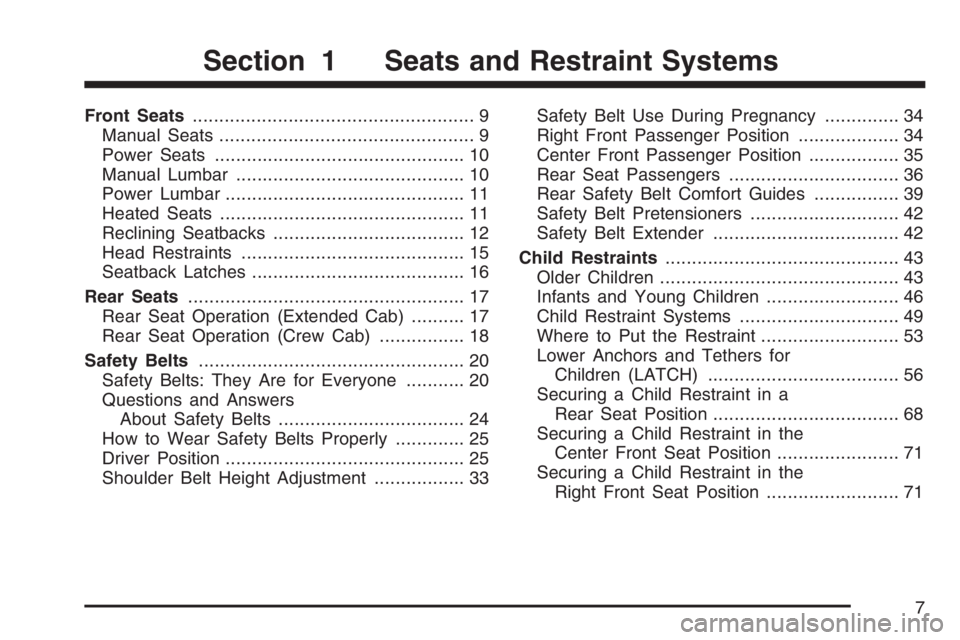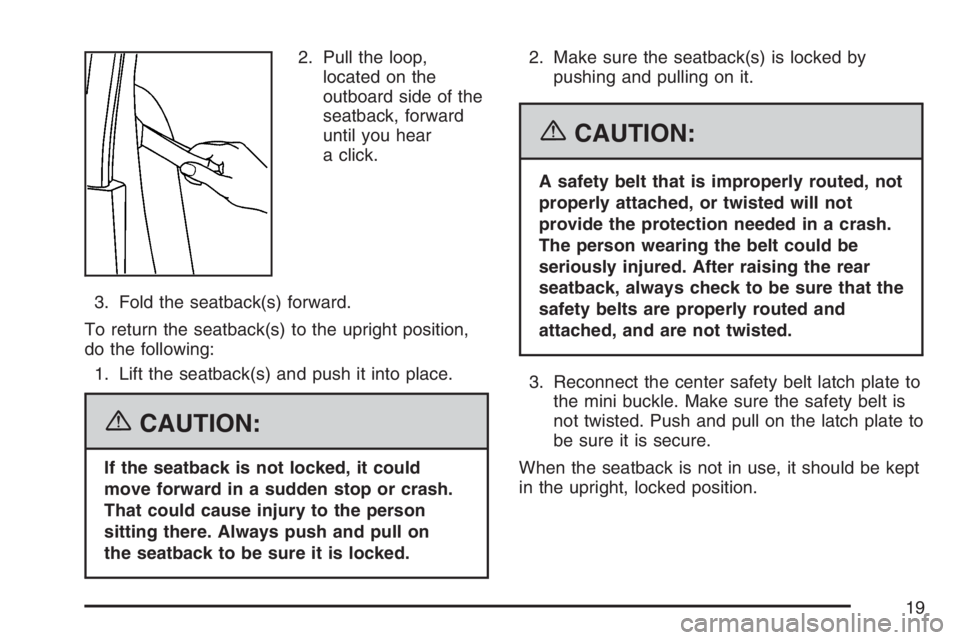Page 7 of 492

Front Seats..................................................... 9
Manual Seats................................................ 9
Power Seats............................................... 10
Manual Lumbar........................................... 10
Power Lumbar............................................. 11
Heated Seats.............................................. 11
Reclining Seatbacks.................................... 12
Head Restraints.......................................... 15
Seatback Latches........................................ 16
Rear Seats.................................................... 17
Rear Seat Operation (Extended Cab).......... 17
Rear Seat Operation (Crew Cab)................ 18
Safety Belts.................................................. 20
Safety Belts: They Are for Everyone........... 20
Questions and Answers
About Safety Belts................................... 24
How to Wear Safety Belts Properly............. 25
Driver Position............................................. 25
Shoulder Belt Height Adjustment................. 33Safety Belt Use During Pregnancy.............. 34
Right Front Passenger Position................... 34
Center Front Passenger Position................. 35
Rear Seat Passengers................................ 36
Rear Safety Belt Comfort Guides................ 39
Safety Belt Pretensioners............................ 42
Safety Belt Extender................................... 42
Child Restraints............................................ 43
Older Children............................................. 43
Infants and Young Children......................... 46
Child Restraint Systems.............................. 49
Where to Put the Restraint.......................... 53
Lower Anchors and Tethers for
Children (LATCH).................................... 56
Securing a Child Restraint in a
Rear Seat Position................................... 68
Securing a Child Restraint in the
Center Front Seat Position....................... 71
Securing a Child Restraint in the
Right Front Seat Position......................... 71
Section 1 Seats and Restraint Systems
7
Page 17 of 492
Rear Seats
Rear Seat Operation (Extended Cab)
If your vehicle has an
extended cab, there may
be forward folding seats
in the rear area.
To fold the rear seat cushion(s) from the stored
position to the sitting position, pull the front of the
seat cushion down completely.
The rear seat storage compartments must be
closed before folding the seat down. SeeRear
Storage Area on page 151.To store the seat, do the following:
Notice:Folding a rear seat with the safety
belts still fastened may cause damage to the
seat or the safety belts. Always unbuckle
the safety belts and return them to their normal
stowed position before folding a rear seat.
1. Secure the safety belt buckle to the inboard side
of the seat with the hook and loop fastener (A),
so that it does not move when not in use.
2. Push the entire seat up until it is �ush with the
trim panel.
17
Page 19 of 492

2. Pull the loop,
located on the
outboard side of the
seatback, forward
until you hear
a click.
3. Fold the seatback(s) forward.
To return the seatback(s) to the upright position,
do the following:
1. Lift the seatback(s) and push it into place.
{CAUTION:
If the seatback is not locked, it could
move forward in a sudden stop or crash.
That could cause injury to the person
sitting there. Always push and pull on
the seatback to be sure it is locked.2. Make sure the seatback(s) is locked by
pushing and pulling on it.
{CAUTION:
A safety belt that is improperly routed, not
properly attached, or twisted will not
provide the protection needed in a crash.
The person wearing the belt could be
seriously injured. After raising the rear
seatback, always check to be sure that the
safety belts are properly routed and
attached, and are not twisted.
3. Reconnect the center safety belt latch plate to
the mini buckle. Make sure the safety belt is
not twisted. Push and pull on the latch plate to
be sure it is secure.
When the seatback is not in use, it should be kept
in the upright, locked position.
19
Page 26 of 492
3. Pick up the latch plate and pull the belt across
you. Do not let it get twisted.
The lap-shoulder belt may lock if you pull the
belt across you very quickly. If this happens,
let the belt go back slightly to unlock it.
Then pull the belt across you more slowly.4. Push the latch plate into the buckle until
it clicks.
Pull up on the latch plate to make sure it is
secure. If the belt is not long enough,
seeSafety Belt Extender on page 42.
Make sure the release button on the buckle is
positioned so you would be able to unbuckle
the safety belt quickly if you ever had to.
5. Move the shoulder belt height adjuster to the
height that is right for you. Improper shoulder
belt height adjustment could reduce the
effectiveness of the safety belt in a crash. See
Shoulder Belt Height Adjustment on page 33.
26
Page 37 of 492
2. Push the latch plate into the buckle until it
clicks. Pull up on the latch plate to make
sure it is secure.
When the shoulder belt is pulled out all the
way, it will lock. If it does, let it go back all the
way and start again.
If the belt is not long enough, seeSafety Belt
Extender on page 42.
Make sure the release button on the buckle is
positioned so you would be able to unbuckle
the safety belt quickly if you ever had to.
3. To make the lap part tight, pull up on the
shoulder part.
37
Page 42 of 492

Safety Belt Pretensioners
Your vehicle has safety belt pretensioners for the
driver and right front passenger. Although you
cannot see them, they are part of the safety belt
assembly. They help tighten the safety belts during
the early stages of a moderate to severe frontal
or near frontal crash if the threshold conditions for
pretensioner activation are met.
Pretensioners work only once. If they activate
in a crash, you will need to get new ones,
and probably other new parts for your safety belt
system. SeeReplacing Restraint System Parts
After a Crash on page 95.
Safety Belt Extender
If the vehicle’s safety belt will fasten around you,
you should use it.
But if a safety belt is not long enough, your dealer
will order you an extender. When you go in to
order it, take the heaviest coat you will wear,
so the extender will be long enough for you.
To help avoid personal injury, do not let someone
else use it, and use it only for the seat it is
made to �t. The extender has been designed for
adults. Never use it for securing child seats.
To wear it, just attach it to the regular safety belt.
For more information see the instruction sheet
that comes with the extender.
42
Page 46 of 492

Infants and Young Children
Everyone in a vehicle needs protection! This
includes infants and all other children. Neither the
distance traveled nor the age and size of the
traveler changes the need, for everyone, to use
safety restraints. In fact, the law in every state
in the United States and in every Canadian
province says children up to some age must be
restrained while in a vehicle.
{CAUTION:
Children can be seriously injured or
strangled if a shoulder belt is wrapped
around their neck and the safety belt
continues to tighten. Never leave children
unattended in a vehicle and never allow
children to play with the safety belts.Every time infants and young children ride in
vehicles, they should have the protection provided
by appropriate restraints. Young children should
not use the vehicle’s adult safety belts alone,
unless there is no other choice. Instead, they
need to use a child restraint.
{CAUTION:
People should never hold a baby in their
arms while riding in a vehicle. A baby
does not weigh much — until a crash.
During a crash a baby will become so
heavy it is not possible to hold it. For
example, in a crash at only 25 mph
(40 km/h), a 12 lb (5.5 kg) baby will
suddenly become a 240 lb (110 kg) force
on a person’s arms. A baby should be
secured in an appropriate restraint.
46
Page 48 of 492

Q:What are the different types of add-on
child restraints?
A:Add-on child restraints, which are purchased by
the vehicle’s owner, are available in four basic
types. Selection of a particular restraint should
take into consideration not only the child’s
weight, height, and age but also whether or not
the restraint will be compatible with the motor
vehicle in which it will be used.
For most basic types of child restraints, there
are many different models available. When
purchasing a child restraint, be sure it is
designed to be used in a motor vehicle. If it is,
the restraint will have a label saying that it
meets federal motor vehicle safety standards.
The restraint manufacturer’s instructions
that come with the restraint state the weight
and height limitations for a particular child
restraint. In addition, there are many kinds
of restraints available for children with
special needs.
{CAUTION:
Newborn infants need complete support,
including support for the head and neck.
This is necessary because a newborn
infant’s neck is weak and its head weighs
so much compared with the rest of its
body. In a crash, an infant in a rear-facing
seat settles into the restraint, so the crash
forces can be distributed across the
strongest part of an infant’s body, the
back and shoulders. Infants always
should be secured in appropriate infant
restraints.
48